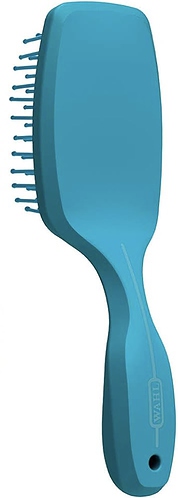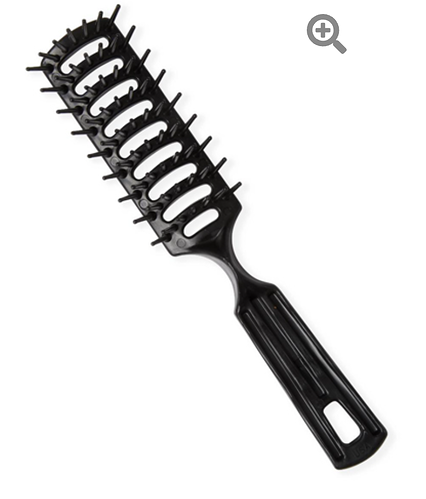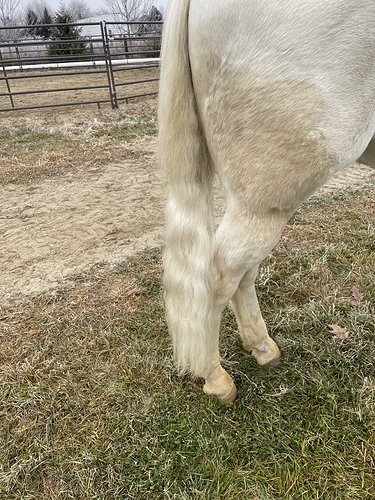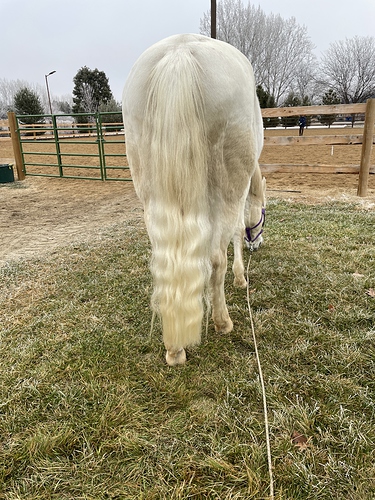I would agree diet is a huge factor in hair and hoof quality. Hooves and hair are made of protein, so horse needs protein intake to help his genetics in growing quality hair coat, hooves, manes and tails. Some equines have genetically thin tails, never going to get huge thick tails whatever they are fed. But even thin tails can have strong hairs, to look nice, gain some length. Related horses we purchased greatly improved over time on our feeding program, with good hoof quality, longer, thicker manes and tails. Takes about a year to get the growth, but hairs are thicker, more lustrous after 4-5 months to contrast the older long hairs. Hooves definatly show the line where feed changes affected wall quality.
We feed soybean meal in our grain mix, which seems to work pretty well with our horses. All have good hoof quality, quite nice tails and manes. Usually we keep tails at fetlock length, with shortening to mid cannon during winter. I shorten in early Nov when winter weather usually arrives. The shorter length prevents much tail dragging to collect ice balls when we get wet snows. I HATE having to go around with a big bucket of hot water and de-ice 8 frozen tails after they come in for the night! Tails are grown back to fetlocks by spring, just need a trim to get bottoms evened out.
I am not much for brushing very often, usually a shake will have stuff (hay wisps, sawdust) fall out of the tail for daily life. I do try to keep tailbone moisturized with mineral oil, which prevents rubbing of tails. Most tails here are so thick the tailbone is waterproof, never gets wet with rain or snow. Dry skin is itchy, so I need to help tailbone get old skin off.
I really like the Tail Tamer brush by Professional Choice that I got at TSC. It is a larger paddle type, has little wavy bristles in colors. They have other models, sizes, but this works well for dry or sprayed hair on REALLY thick and medium thick manes and tails. The S brush also from TSC is very inexpensive, has longer ball ended bristles that help get deeper into thick tails. Wide teeth comb is part of the comb-out, smoothing package here for manes and tails. I don’t comb or brush out tails very often, not even weekly unless they get something tangled in it. Manes and forelocks are kept short, easy care, out-of-the-eyes, swiped smooth with brush or comb when we are using the horse.
I section tails, with unneeded hair put back in sections with a simple overhand knot to keep it out of the hair section I am working on. Heavily conditioned hair can be slippery, so sometimes clips to section hair will work better than knotting. Bottom to top brushing always. The above brushes are working quite well for me. I was using the Dollar Tree brushes Two Dogs pictured on the medium thick tails, then we got Luke with his huge tail and they were not working for him.
Luke is a Purebred Cleveland Bay stallion with enough tail hair for 3 normal horses! He does NOT like wearing a braided tail, gets rather agitated over it. Husband says braided (one big braid or multiple small braids) tail gets swished on his testicles and hurts him. So then he swishes more! NOT worth making him crabby, so his tail is always down. I just need to plan extra time to brush it out when he goes places. No one here wears a tail bag or braided tails because they get turned out daily, no chance of tails getting snagged on anything and getting pulled out. Seen that happen in “safe” paddocks and fields, a stall with a cracked board that tail got caught on.
I use human conditioners on tails, manes, cheaper in quantity than horse products. We always get compliments on how nice the horses look.
We have been using the soybean meal in the grain mix for years, really happy with how well it works on all our horses. We have shared our “recipe” with those who ask for it. They have all been really happy with the looks on their variety of breeds and performance results. It is 10% of the mix, feeding more to equines over yearling age is wasting your money, body doesn’t use it. We fed one older horse rice bran for a year to help add some “finish.” No change in hair quality beyond it making her almost waterproof! She just did not get wet to the skin unless shampoo was involved. We bought an App gelding with a naked tailbone. Kept in a dirty barn full of flies he was trying to swish off. I thought no-tail was situational because I had his sister that had a lovely, fetlock long tail. We brought him home in the fall and I kept that tailbone Vasalined every couple days to moisturize and protect the skin and couple hairs he had. He managed to grow hair over winter without any flies, almost to a bobtail length by spring! The improved diet, moisturizing of skin, new hair all added up to tail growth over time. His yearling registration pictures showed a hock length tail, which he surpassed when we sold him a couple years later. Thick, shiny, long in various colors, only needing tailbone moisturizing every month or so. Great Appy hard hooves, only shod because I was riding more miles than he could grow hoof fast enough. So diet for me, is the big factor in hoof, hair quality and growth.






 . I can’t imagine having it all braided and whacking herself with it repeatedly on a summer day. That is why it has poop in it…that washes out vs being beat with a heavy switch repeatedly. I have never had much luck with wrapping or a tail boot. Her fish line gauge of hair can pop anything off of it in short order.
. I can’t imagine having it all braided and whacking herself with it repeatedly on a summer day. That is why it has poop in it…that washes out vs being beat with a heavy switch repeatedly. I have never had much luck with wrapping or a tail boot. Her fish line gauge of hair can pop anything off of it in short order.